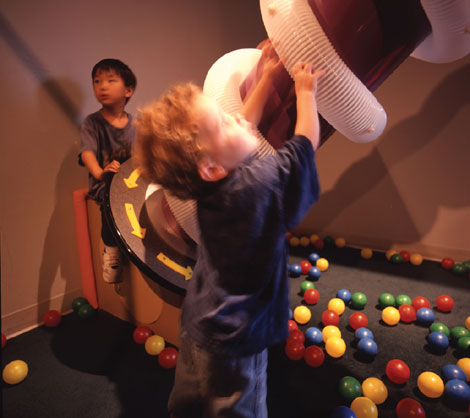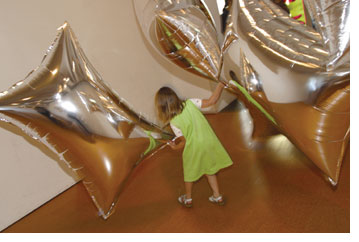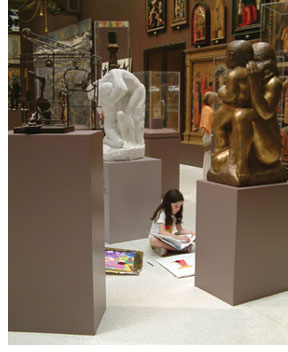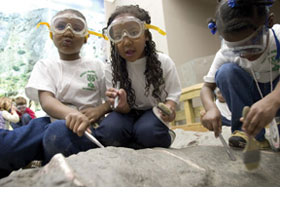For the Littlest Learners
By Kimberly
M. Riel

Young
children love playing and learning in Carnegie
Science Center’s Exploration Station,
Jr.
“I like her!” said
2-year-old Hannah to her mother as she sat down
beside Julie Williams, an educator from Carnegie
Museum of Art who was leading a play-date at
the museum one warm July morning. Together with
their parents, Hannah and five other toddlers
were in the sculpture garden at Carnegie Museum
of Art, hard at work and remarkably engaged.
They were making trees out of pieces of paper,
spongey material, feathers, pastels, and glue
following a brief discussion about a work of
art that they had seen earlier in the museum’s
entrance gallery. For 20 minutes, the entire
group was totally engrossed in their art-making.
When the play-date was over, each child proudly
shared his or her artwork with the group before
they all darted off to run and jump on the garden
steps.
As they giggled, screamed, and
chased each other, the children seemed to forget
everything
they
had just accomplished, but Julie was satisfied.
As a recent Carnegie Mellon University graduate
with a degree in psychology and a teaching
certificate from Chatham College, Julie knew
that she had
achieved her goals for the play-date: the kids
had fun, and the parents learned how they can
structure a future museum visit so their children
will enjoy it.
“
I think all the kids had a good time, and that’s
the whole idea,” says Williams. “A
child’s work is play, and when they play,
they learn. While they won’t remember anything
specific about the artwork we saw today, they’ll
remember the experience they had and they’ll
relate it to other things in their life. On a
very concrete level, they practiced some fine
motor skills, developed their social skills,
and challenged their emotional and language skills.
But I don’t think even their parents realized
that!”
How Children Learn
To a casual observer, the Museum of Art play-date
may have looked like organized chaos. However,
to an early childhood educator, it was a developmentally
appropriate activity. By piquing the children’s
curiosity about the subject of trees and then
allowing them to move around freely and make
their own trees at their own speed in a safe
and stimulating environment, Julie matched
the learning environment—the materials,
schedule, lesson, teaching methods, and physical
set-up—to the children’s developmental
level.
 Psychologist Jean Piaget was the first
to study young children’s behavior and
develop the concept that children pass through
four stages
of development on their way to adulthood. The
children who participated in the Museum of Art’s
play-date ranged in age from 2 to 3 1/2 and fit
into Piaget’s sensorimotor (infant to age
2) and preoperational (ages 2 to 6) stages. Psychologist Jean Piaget was the first
to study young children’s behavior and
develop the concept that children pass through
four stages
of development on their way to adulthood. The
children who participated in the Museum of Art’s
play-date ranged in age from 2 to 3 1/2 and fit
into Piaget’s sensorimotor (infant to age
2) and preoperational (ages 2 to 6) stages.
“
Children in the preoperational stage learn by
exploring the world around them physically, through
activities that encourage them to manipulate
things, and mentally, by considering questions
or situations that cause them to wonder about
something,” says Melanie Dunn, a child
development specialist and professor at Duquesne
University and an educator at Carnegie Museum
of Art. “They’re also still sensorimotor
learners, which means they constantly want to
move around and smell, touch, taste, hear, and
see everything.
“
For children in these stages, the Museum of Art
has designed programs that encourage them to
explore, invent, and create their own theories
about the world by introducing them to a piece
of art and then letting them create their own
artwork based loosely on the piece we discuss,” adds
Dunn. “We always choose subjects that are
familiar to the children so they make an immediate
connection, and we make the visit very interactive
so they remember it.”
Comfortable Kids Make Lively Learners
“
We want people to know that the museums are excellent
places to bring young children to have fun and
to learn,” says Shirley Rust, program assistant
in the Discovery Room at Carnegie Museum of Natural
History. “Museums present children with
a unique learning environment—where else
can you see raw gems and real dinosaur fossils?
And while most of the exhibits in the museum
are for eyes only, there are a lot of things
that are very hands-on and perfect for young
children who are just learning to decode the
world by touching and questioning everything.”
 While
the exhibits in the Museum of Natural History’s
Discovery Room are designed to stimulate curiosity
and imagination in people of all ages, they
are especially appealing to young children
because
the room is very home-like and everything is
within their reach. “The Discovery Room
is nice because it gives children another way
to learn about the things they see in the exhibits
upstairs,” says Rhonda Kelly, Discovery
Room program assistant. “But the best
thing about the Discovery Room is that it encourages
interaction between families and brings out
the
child in everyone.” While
the exhibits in the Museum of Natural History’s
Discovery Room are designed to stimulate curiosity
and imagination in people of all ages, they
are especially appealing to young children
because
the room is very home-like and everything is
within their reach. “The Discovery Room
is nice because it gives children another way
to learn about the things they see in the exhibits
upstairs,” says Rhonda Kelly, Discovery
Room program assistant. “But the best
thing about the Discovery Room is that it encourages
interaction between families and brings out
the
child in everyone.”
Providing stimulating
settings that foster parent-child and child-child
interaction and
allow for hands-on
activities is important to the education staff
at all four museums because children need to
feel comfortable in order to play freely and
learn effectively. At the Museum of Natural
History, the Discovery Room provides such a
setting, as
do the Discover Carts, which are staffed by
teen docents and located throughout the galleries.
Following the renovation of the Scaife Galleries,
the Museum of Art placed cozy couches throughout
the galleries where families can gather to
look at the artwork and read children’s
books about colors and images in art. And the
ARTventures
drop-in activity stations for families with
children make the galleries especially interactive
every
weekend. “Our weekly ARTventures projects
are designed to encourage both children and
adults to explore their reactions and responses
to a
work of art in the museum’s collection,” says
Marilyn Russell, Carnegie Museum of Art’s
curator of education. “The art-making
activity helps to stimulate conversation among
families
by sparking an exchange of ideas about the
piece. And since it takes place in the gallery
where
the work of art is located, not in an art center
someplace else, it helps to assure families
that a museum can be an interactive place where
you
can do a variety of things.”
At Carnegie
Science Center, exhibit areas created especially
for young children are marked with
tiny yellow handprints, and Exploration Station
Jr. is a 6-and-under-only zone designed to
encourage exploration and discovery through
hands-on activities.
It’s a parent’s and toddler’s
dream come true—with a Junior Lab, which
invites kids to explore different science careers;
a Construction Zone, which prompts kids to
sort and count materials while introducing
them to
the basics of physical science; a Ball Factory,
where kids are introduced to the concepts of
simple machines, colors, gravity, and teamwork;
a huge Water Zone; and a Quiet Spot where families
can talk about what they’ve explored,
read books or do puzzles together, and prepare
for
their next adventure.
At The Andy Warhol Museum,
families with children gravitate to the Silver
Cloud artwork where
they can play together with large floating
silver
pillows. Or they gather together in the Education
Studio, where every weekend—as part of
The Warhol’s Weekend Factory—The
Warhol staff offer art-making activities appropriate
for even the youngest child.
 Learning Through
Play Learning Through
Play
With hands-on exhibits filling all five floors,
it’s easy for parents to recognize the
potential for fun and learning at Carnegie Science
Center, yet many think The Andy Warhol Museum
is inappropriate for young children. Think again.
“
As an artist, Andy Warhol played continuously,
and his art has a strong appeal to children,” says
Jessica Gogan, assistant director for education
and interpretation at The Warhol. “There
are vivid colors, enormous soup cans, and bright
yellow wallpaper printed with fluorescent pink
cows.
“
The Warhol offers a setting that is very open
to a child’s natural sense of play, and
it encourages adults to play as well,” adds
Gogan. “As adults, we recognize that play
is a vital part of a child’s development
and learning, yet play is every bit as important
to adults.
“
Play opens up the psychological space needed
for seeing new ideas, and it spurs imaginative
thinking,” says Gogan. “When we’re
playful, we’re relaxed and can think out
of the norm. Play is very important to the imagination
and problem-solving world of adults, and we often
don’t do enough of it.”
“
Playing together is the key,” notes Jessica
Stricker, director of educational experiences
at Carnegie Science Center. “When parents
or grandparents and children play together, the
whole world opens up.
“
Teachable moments pop up everywhere. Sometimes
it’s the child who is learning; sometimes
it’s the parent or grandparent who learns
something new; and sometimes they’re all
learning together. No matter what the scenario,
it’s fun for everyone, and that’s
the ultimate goal—to enjoy being, and learning,
together.”
Back to Contents
|